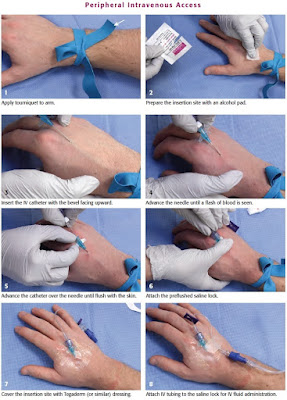Tricks how to hit a vein every time
Tricks how to hit a vein every time
venipuncture, how to hit a vein, IV insertion, vein access tricks, intravenous therapy, hitting a vein every time, vein finder, anesthesiology tips, myocardial protection, difficult veins, IV catheter placement, vein dilation, tourniquet technique, phlebotomy skills, needle insertion.
Choosing the Catheter Gauge depends on the clinical scenario:
Choosing the Appropriate Site:

- 16-gauge-: large amounts of fluid must be given quickly;
- 20 or 18 gauge: administration of blood products;
- 22 gauge: routine administrationof maintenance fluids and antibiotics
- 18-gauge for IV contrast–enhanced computed tomography (CT) studies, pulmonary CT angiogram.
- 22-gauge catheters: hand veins
- Large-bore IV lines: cephalic, accessory, or basilic veins
- Avoid veins that are not resilient and feel hard or cordlike because they are often thrombosed
- In patients who have undergone radical mastectomy, avoid the arm on the same side as the surgery because IVs may impair circulation, affect flow, or lead to edema.
Tricks for Finding a Vein:
- Ask patients to open and close their fist
- Lowering the arm below the level of the heart
- Light tapping can likewise be effective, although heavy tapping may cause the vein to spasm.
- heat packs can be applied for 10 to 20 minutes to increase venous engorgement.
- Nitroglycerin ointment.
- Once the tourniquet is applied to the wrist, apply a quarter inch of 2% nitroglycerin to a 2.5-cm2 area, leave it on for 2 minutes, and then rub it off
- The combination of topical nitroglycerin with local anesthetics has been shown to increase success and decrease the pain
Cannulation:

- Wash your hands, wear gloves.
- Clean the injection site with iodine, alcohol, or both.
- Stabilize the vein: position one’s thumb alongside the vein and pull down while the index finger is positioned more cephalad and pulls upward.
- Take the angiocatheter, angle the angiocatheter 10 to 30 degrees between the catheter and the vein.
- Puncture the vein. Once a flash of blood is seen, advance the catheter several millimeters more to ensure that the catheter has entered the vein and not just the wall.
- Avoid advancing too far and puncturing the posterior wall.
- Advance only the catheter, not stylet. Use the fingers to occlude the vein at the tip of the catheter to prevent extravasation of blood from the angiocatheter.
- Remove the needle; connect the saline lock, IV lining, or syringe for phlebotomy; and release the tourniquet.


